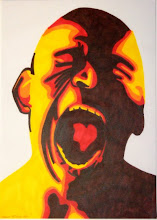Girl, Interrupted (James Mangold, 1996)
This film flexes its muscles as a neo-hollywood memoir drama, with everything wrapped neatly with big bows on top and tags that read "Columbia Pictures". There's Those big inviting Angelina lips, Winona Ryder's mastery of the three carrot diet, The amorphous set of a mental institution, and the ace job of the overpaid, sixties-hairstyle and wardrobe experts. There's even a big old dose of Whoopee Goldberg packed in to this Oscar-army, filling out the triple star power triumvirate.
Oh my god, I forgot to mention the twist! Mangold breaks out of the mold with a wandering chronology and temporal dislocation to accent Ryder's intense psychological narration. She constantly keeps giving you that familiar "she's so poetic and unstable" inkling that LA Weekly always just eats up like mad (pun intended).
Ryder and Jolie unknowingly evoke the angst and conceit of my favorite form of entertainment, that of the modern beat-loving amateur teenage writers and sociopaths, with their standard private school educations, dysfunctional but affluent parents, and of course, the expected prevalence of a well acted, attention-seeking faux mental disorder (usually falling under what are considered today as "cool" syndromes like schizo-affective or manic depression diagnoses). We know these characters, and how inevitably the maladies that these liars choose are always those that only exhibit nonphysical symptoms, and can therefore only be assessed in the methods of abstract medicine, (through therapy or by examining behaviors).
In the credits as the film ends, it seems to have become clear to me that it is actually the film itself that suffers from a severe personality disorder. The piece throughout seems to work well, banking on most people's silent fascination with mental disorder and the routines of institutionalization. However, once the plot is revealed as being based on non-fiction, this deception becomes the one thing that ruins the films strength and effectiveness. The film's 'pathos' quickly is instead identified as 'bathos' despite its level of technical execution, simply due to its selective derangement of the film's source material.
Adapted from the novel by the same name, the only "girl" who seems to have been truly "interrupted" is the novel's author, Susanna Kaysen. The bestselling book which Kaysen wrote is, like the film, an autobiographical memoir. Thus her reaction to the film calling it "melodramatic drivel" would seem to denote a major gap in existence between the histrionic cinematic version and the factual accounts given in the book.
Most moviegoers would shrug blindly at this invisible travesty, as the character Winona depicts matches at least in a very general demeanor how Kaysen's battle with her disorder and the record of her experiences actually occurred. They ignore that the author's emotional words have been cheapened into a flashy, trite exploitation showcasing an irritating nervous breakdown, carelessly vamped up for the screen with one single paint coat of slick, canned cinematic dramaturgy.
Including myself in the minority of impassive viewers, what seems to have happened in the case of Girl, Interrupted is, quite conveniently, a situation quite well-mirrored by the films plot itself. In Girl Interrupted the literary work, a young writer suffers from a desire to use her creative work as a vehicle for escaping the throes of an oppressive system holding her by the ankles. This can only happen, however, if he or she can first find a way to create a turmoil or crisis that warrants the inspiration necessary to succeed.
The act of writing Girl Interrupted cinematically instead involved three writers: an established screenwriter, Anne Hamilton Phelan, the director, James Mangold and the playwright, Lisa Loomer, combined in stealing the central role. They collaboratively invented the drama and turmoil themselves by boldly inserting it into the writing even if it was fabricated. The group was similarly attempting to create their first Oscar-worthy vehicle in an effort to escape the trappings of the hollywood system holding their ankles. Unfortunately, they did this while completely ignoring the moral dilemma implicit in their decision to misrepresent the author's original work.
So, whereas Kaysen succeeds in escaping these chains of her literary anonymity by recounting her compelling story as it occurred, as well as learning to curb her disorder along the way, the film edit still remains trapped in the boiler plate factory of hollywood with its vicious traditions, simply by improving upon work that needed little improvement.
The threesome's final script is certainly what 'mangles' the essence of Kaysen's fantastic novel by foolishly 'looming' over the originality of her literary voice and her altruistic realism with overdone theatrics and catchy industry hooks. The film as a singular entity is entertaining and even powerful at times. Honestly, Winona, Whoopee and Angelina deserve every accolade they got for their performances, as they completed their jobs with the utmost emotion and expertise. But the sheer tenacity of the adaptation being heralded for falsifying someone's life-story after being entrusted with their personal work, is what makes me almost ready to be commited myself.
Subscribe to:
Post Comments (Atom)

No comments:
Post a Comment